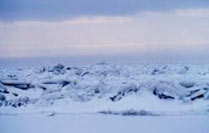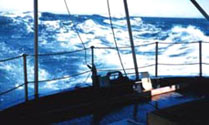What differences have occurred in summer and winter weather in the Bering Sea in the past 30 years?
Dr. Nicholas A. Bond
NOAA/PMEL - University of Washington/JISAO
The weather of the Bering Sea fluctuates on time scales ranging from days to decades. It is known that these fluctuations cause changes in physical ocean properties, which in turn can often be linked to shifts in marine populations. Therefore, it is interesting and important to consider how the weather of the Bering Sea has varied over the last few decades. The crucial aspects of the weather in winter are different than those in summer, and so we consider those times of year separately.
Differences in recent winter weather
 |
| Ice fields in Winter in the Bering Sea |
The Bering Sea is quite stormy through much of most every winter. But the nature of these storms varies a great deal. One type of atmospheric circulation pattern produces a parade of cyclonic, low-pressure systems from the southwest, and while the winds with these storm systems can be fierce, the air temperatures are relatively moderate, leading to a retreat in seasonal sea ice. Another type of circulation pattern leads to more frequent and intense arctic-air outbreaks from the north and hence advance in the ice edge. The overall weather conditions in winter depend on the tendency for one type of pattern versus the other, and this tendency one way or another lasts from months to decades. For example, the early 1970s featured a strong propensity for colder winds from the north and extensive and long lasting ice packs. This period was followed by a prominent warm period from the late 1970s through much of the 1980s with reduced ice cover. At St . Paul in the Pribilof Islands, the average winter air temperatures warmed a whopping 8 degrees Celsius during this transition.
 |
| Surface temperature as a measure of Winter severity in the Bering Sea (Bond and Adams, 2002). |
The winters of the last decade or so have been slightly warmer than normal on average. There has been a tendency for the sea ice to retreat sooner than normal, in other words, spring has been occurring a week or two earlier. It bears noting that the winter of 2002-03 was one of the warmest on record in the eastern Bering Sea and western Alaska; it is unknown whether this represents more a fluke or more a harbinger of what winters will be like in the future.
Differences in recent summer weather
The weather of the Bering Sea is generally much more tame during the summer, but that does not mean it is unimportant to the marine ecosystem. Probably the two key factors to the ocean in the summer are the heating by the sun, which is related to the fraction of the time the region is blanketed by clouds, and the stirring or mixing by the winds, which is related to the frequency and intensity of the occasional, moderate storms that occur. In each case, unusual weather over a relatively brief period can dominate the net forcing of the ocean by the atmosphere. In other words, a few weeks featuring an especially clear period or a series of relatively vigorous storms can dominate the degree to which a whole season is different from normal. The data record for the eastern Bering Sea shelf indicates considerable year to year variability in the summer weather, just like in winter.
 |
| Stormy weather in summer in the Bering Sea |
Unlike winter, however, there also appears to be a systematic if irregular trend towards warmer summers. The sea surface temperature (SST) on August 1 the last decade or so is about 1 degree Celsius greater that it was during the 1960s and 1970s. This may not sound like much, but it is actually a significant change as far as climate records are concerned. The warmer SST in recent times can largely be attributed to a bit more solar heating of the ocean, and a bit less mixing of cold water up from depth. An extreme example of these effects acting together occurred during the summer of 1997, when the SST over the Bering Sea shelf reached 14 degrees Celsius or more than 2 degrees above normal. It is quite possible, but by no means certain, that these kinds of summers will become more and more likely.
References:
Bond, N.A., and J.M. Adams, 2002: Atmospheric forcing of the southeast Bering Sea shelf during 1995-99 in the context of a 40-year historical record. Deep-Sea Research, Part II, 49, 5869-5887.
Reynolds, R.W., and T.M. Smith, 1994: Improved global sea surface temperature analyses using optimum interpolation. J. Climate, 7, 929-948.
Additional Information:
For more information on winter severity measures, see the Bering Climate Data website, at http://www.beringclimate.noaa.gov/data/. Under the "Ocean" category, choose "Surface Temperature, M2", and at the top of the page, click on "All Info".
